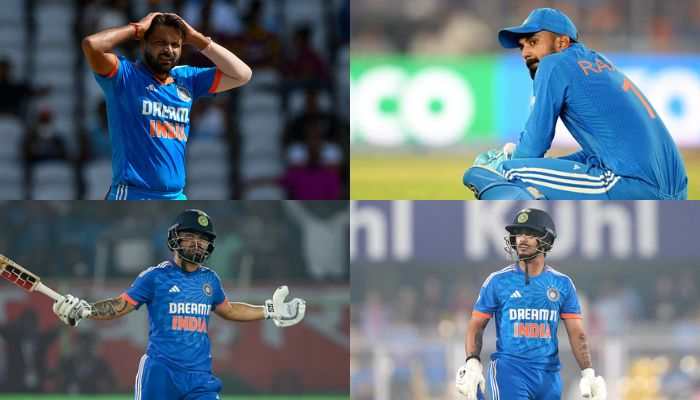Republic Day: With Emmanuel Macron As Chief Guest, India To Showcase Its Military Prowess With These Advanced Weapons
The Republic Parade 2024 is scheduled to be kicked off with a march by a band and marching contingent from France.
Trending Photos
)
NEW DELHI: India's military prowess, cultural diversity, and many other unique initiatives will be witnessed during this year's Republic Day celebration on Friday. President Droupadi Murmu will lead the nation in celebrating the 75th Republic Day from Kartavya Path in the national capital. French President Emmanuel Macron will be the Chief Guest at the parade.
The first contingent in the uniform of the 61 Cavalry will be led by Maj Yashdeep Ahlawat. The 61 Cavalry is the only serving active Horse Cavalry Regiment in the world, with the amalgamation of all the 'State Horse Units'. The Indian Armed Forces has been rendering its selfless service to the nation and its countrymen, ensuring stability and dominance on the frontiers along the Line of Control (LoC), the Line of Actual Control (LAC) and worldwide through UN Peacekeeping missions.
The Republic Parade 2024 is scheduled to be kicked off with a march by a band and marching contingent from France. This year, the weapon systems to be showcased at the Republic Day parade include Tank T-90, Nag anti-tank guided missiles, Pinaka multi-barrel rocket launchers, Weapon Locating Radar System- SWATHI among others.
Tank T-90
The next detachment will be of Tank T-90 BHISHMA, led by Lt Fayz Singh Dhillon of 42 Armoured Regiment. Bhishma Tank is a 3rd generation Russian Main Battle Tank armed with 125 mm smooth bore gun. T-90 functions on the hunter killer concept. It can fire four types of ammunition and also has the capability of firing a missile from gun upto range of 5000 mtrs. Bhishma tank can hunt and kill at night effectively with the help of thermal imaging sight. It also has ERA panels which makes the armour of this lethal machine even stronger. The 46-ton giant machine can move upto a speed of 50 to 60 km per hour and can operate in all types of terrains effectively. The colours of the Regiment are FRENCH GREY, MAROON, BLACK. Its motto is 'Karam Shaurya Vijay' (Action Courage Victory).
Nag Missile System (NAMIS)
The next detachment will be of NAG Missile System of Mechanised Infantry Regiment led by Capt Abhay Pandit of 17 Mechanised Infantry Regiment. The System popularly called NAMIS is a tank destroyer indigenously designed by the Defence Research & Development Laboratory Hyderabad. It consists of a tracked Armoured Fighting Vehicle, which has a crew-less turret capable of firing six 'Nag' Anti-Tank Guided Missiles.
The NAMICA (Nag Missile Carrier) is a stretched, license-built BMP-2 with additional wheels, nicknamed "Sarath" in India. Classified as a tank destroyer, it is equipped with various electro-optical systems including a thermal imager (TI) and a laser rangefinder (LRF) for target acquisition. The NAMICA carries a total of 12 missiles, with six in ready-to-fire mode and six in storage. It has a compact auxiliary power unit (APU) for silent watch operation, a fire detection and suppression system (FDSS) and nuclear, biological and chemical protection system (NBCPS). The carrier weights 14.5 ton in fully combat load and is capable of moving 7 Km/hr in water. NAMICA can fire missiles at a target located around 7.5 Km with hunter-killer sight capability and carries 4 Military personnel. Its motto is 'Satrah Mech Har Maidan Fateh'.
BMP 2/2K
Next to the saluting dais will be the mechanised column of Infantry Combat Vehicle BMP - 2 /2K of GUARDS Regiment led by Lt Shivam Singh of 23 GUARDS. ICV BMP-2 named SARATH, is a high mobility Inf Combat Vehicle (ICV) with potent armament and state of the art night fighting capability, which makes it capable to destroy any unknown enemy target upto a distance of 4 ICms at night. It can operate effectively in all battlefield terrains of desert, mountainous region or high-altitude area.
The ICV is equipped with 30mm Automatic Cannon Gun, 7.62mm PKT & Konkurs missiles, upgraded with Thermal Imaging (TI) night sights. Being an all-weather amphibious combat vehicle, ICV (BMP-2) is battle ready for full spectrum of challenges & conflicts and thus truly considered as Backbone of Indian Army's Mechanised Warfare. While its motto its Pehla Hamesha Pehla, its war cry is Garud Ka Hoon Bol Pyare.
All Terrain Vehicles
The next detachment will comprise six modern specialist vehicles, including 'Quick Reaction Force Vehicles -- Heavy and Medium, a Light Specialist vehicle, Vehicle Mounted Infantry Mortar System, All-terrain vehicle and a Specialist Mobility Vehicle. The detachment is led by Major Toofan Singh Chauhan, 5 Rajput on All-Terrain Vehicle, Lt Col Panmei Kabiphun on Light Specialist Vehicle, 19 Maratha Light Infantry & Capt Armandeep Singh Aujla of 2nd Battalion of the First Gorkha Rifles on QRFV.
Pinaka
The next detachment will be of PINAKA of the Regiment of Artillery from 1890 Rocket Regiment, led by Lt Priyanka Sevda of 262 Field Regiment. Pinaka Multiple Launcher Rocket System is an indigenously designed, developed and manufactured medium range, all weather and free flight artillery rocket system.
It is fully automated, offensive weapon system with each launcher boasting of 12 rockets of 214mm caliber having a range of 37.5 kilometer. Its motto is `Sarvatra Izzat 'O' Iqbal - 'Everywhere with Honour and Glory'.
Weapon Locating Radar System- SWATHI
The next detachment will be of SWATHI - Weapon Locating Radar System, led by Lt Deepti Rana of Regiment of Artillery. Weapon locating radar SWATHI, developed by DRDO and Bharat Electronics Ltd, is highly mobile radar system designed for automatic first round detection SWATHI is a coherent
c-band, passive electronically scanned phased array radar intended to be used as weapon locating radar and for direction of own artillery fire (DOOAF).
SWATHI is a two tatra vehicle configuration system comprising radar vehicle and power source cum bite (PSB) vehicle with twin generators and the auxiliary components. It has the capability to classify projectile targets and rejection of unwanted targets (Clutter/Aircraft). SWATHI being a phased array radar operates in Cband with fence detection mode of operation, ensuring first detection and tracking of shells, motors and rockets. In its secondary role, it can track and direct friendly artillery fire. The radar can provide corrections to projectile trajectory of friendly artillery to pin point the fire towards enemy.
Sarvatra Mobile Bridging System
The next detachment will be of 'Sarvatra Mobile Bridging System' of Corps of Engineers led by Capt Suman Singh of 9 Rapid Engineer Regiment 15m Sarvatra Mobile Bridging System is a "Made in India' specialized equipment to be employed by Engineer units for bridging over dry and wet gaps. This vehicle-mounted, multi-span, mechanically-launched mobile bridge system is designed for speedy deployment and retrieval under tactical conditions.
It has a capability of spanning a minimum of 15m in single span, and a maximum of 75m in multi-span. The deployed bridge equipment is suitable for the crossing of 'A' as well as 'B' vehicles upto a load class MLC-70.
Drone Jammer System
The next detachment will be of Mobile Drone Jammer System and Advance Radio Frequency Monitoring System of the Corps of Signals. Upfront is the detachment of Drone Jammer System led by Lt Col Ankita Chauhan of 11 Electronic Warfare Battalion. Drone Jammer System of Indian Army is used to detect and track drones and UAS (Unmanned Aircraft System) signals (downlink), as well as ground control signals (GDT, Uplink) and to jam drone activities.
The electro-optical sub-system serves to identify, track and verify the target. Besides detection and tracking of drones, The DJ System can neutralize hostile drone activities using Directional high-power smart jamming of drone UAS control uplink signals. The DJ system is installed on two high mobility standard 2.5-ton vehicles. The DJ system is equipped with electro-optical subsystem and RF sensors to scan the radio frequencies.







)
)
)
)
)
)
)
)
)
)
